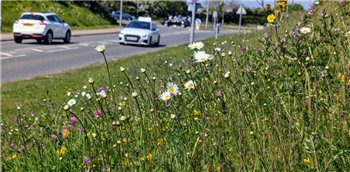04/09/2025
Lost habitats are back to breathe life into nature

Nature’s been given a helping hand in Denbighshire for the last six years thanks to a project working to restore lost habitats.
Our Wildflower Meadows Project which started in 2019, aims to restore and increase this habitat in the county as since the 1930s. The UK has lost 97% of its meadow land, with Wales in particular having less than 1% left. This loss has impacted heavily on nature and communities.
The project is also part of our wider Bee Friendly campaign aimed at supporting the recovery of bees and other pollinators across the county
Our meadows are usually left uncut between March and August, except a small border mown around each site, allowing the flowers to set seed, and ensures that the meadow provides the greatest benefit to wildlife.
Cut and collect is carried out at the sites to help to lower the richness of the soil, and create the low-nutrient ground that our native wildflowers and grasses need to thrive.
Grass and wildflower seeds collected from areas around the county have been used to enhance our meadows. Some of the seeds have also been grown on at our tree nursery to produce plug plants. Only using local seeds ensure the plants which then grow are genetically suited to Denbighshire and will be the most beneficial to biodiversity in the area.
Here County Voice takes a look back at some of the project highlights that have benefitted both plant and wildlife across Denbighshire.
During 2021 the Biodiversity team recorded a nationally declining species on the Prestatyn Beach Road West site.
Hound’s tongue (Cynoglossum officinale) and was previously only recorded in Denbighshire 18 times within the last 116 years.
Seeds were taken from the site to the Council’s tree nursery and thanks to the effort of the staff, new plants germinated for planting on other coastal meadow sites to help expand its range in Denbighshire.
In 2021 Bithynian Vetch, a species of flowering plant in the bean family Fabaceae grew on a single project site managed by the Biodiversity team. Since 2019, this was the only place in Wales it was recorded growing in the wild.
During June staff collected a small number of seeds from the Bithynian Vetch. These were taken back to the Council’s tree nursery at St Asaph to be grown on site to help boost the plants dwindling numbers.

An innovative organic method was carried out as well in 2021 to help control the length of grass in a Denbigh meadow.
The site was treated with locally sourced Yellow Rattle seeds. Yellow rattle is a parasitic plant, tapping in to the roots of grasses and other neighbouring plants and stealing their nutrients. This reduces the dominance of grasses within a meadow, allowing more native wildflowers to take hold.
During the 2022 season the Biodiversity team inspected the site and found a reduction in grass length and an increase in wildflowers. The successful trial meant more food for pollinating insects and their predators
‘Bee Friendly’ really came into its own in 2023 after the Biodiversity team found a new resident at a Ruthin meadow.
A female Tawny mining bee was found resting in a nest on the site. The spring flying bee with dense orange and red hair feed from a variety of flowers which make wildflower meadows the perfect area to locate to.
Tawny mining bees are usually seen from March to June and are common throughout south and central Britain. This showed how designated sites are providing support for local nature to flourish as well by providing plants for pollinators and grass for insect food.
The team also discovered during this season pyramidal orchids at two coastal sites at Prestatyn which was recorded as a first.
And last year a pyramidal orchid was discovered inland at a meadow in Ruthin indicating the network of meadows were really starting to help nature fightback.

This year extra bee orchids were discovered at a meadow in Denbigh which shows the meadows are working as a combined highway for plants, insects and animals to move across the county, increasing biodiversity as they go.
Orchid produce seeds which are incredibly small (also known as dust seeds). These seeds must come in contact with a special type of mycorrhizal fungi that will help the orchid seed germinate and aid it in its early growth. Each orchid tends to have a particular mycorrhizal fungi that it partners with, so unless the soil conditions are right for the fungi, orchids won’t grow. The resurgence of orchid shows the project in 2025 is heading in the right direction, and the meadows are continuing their journey to recovery.